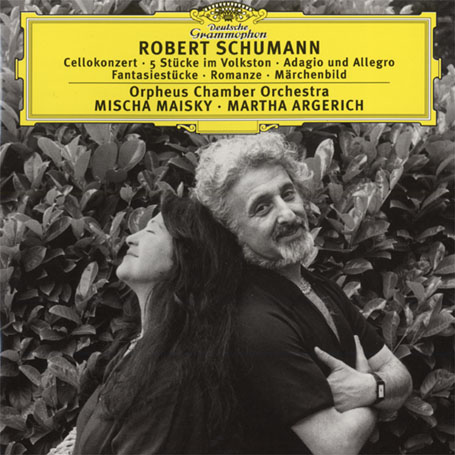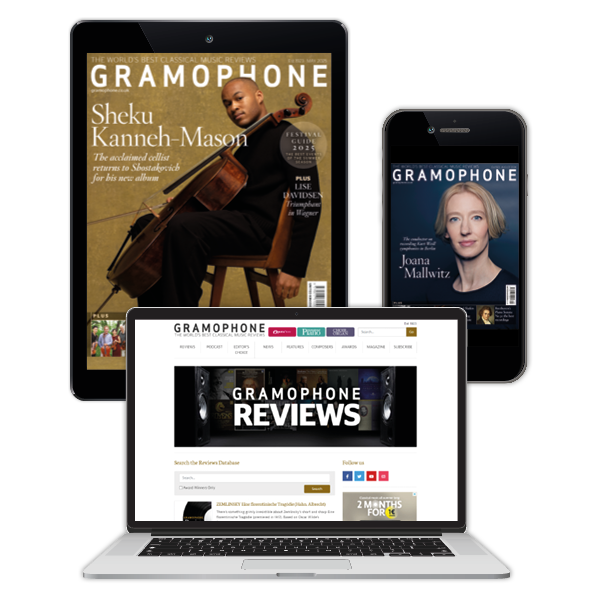Schumann Cello Concerto etc
View record and artist detailsRecord and Artist Details
Composer or Director: Robert Schumann
Label: DG
Magazine Review Date: 5/2001
Media Format: CD or Download
Media Runtime: 71
Mastering:
DDD
Catalogue Number: 469 524-2GH

Tracks:
| Composition | Artist Credit |
|---|---|
| Concerto for Cello and Orchestra |
Robert Schumann, Composer
Mischa Maisky, Cello Orpheus Chamber Orchestra Robert Schumann, Composer |
| Adagio and Allegro |
Robert Schumann, Composer
Martha Argerich, Piano Mischa Maisky, Cello Robert Schumann, Composer |
| (3) Fantasiestücke |
Robert Schumann, Composer
Martha Argerich, Piano Mischa Maisky, Cello Robert Schumann, Composer |
| (3) Romanzen, Movement: No. 1 in A minor |
Robert Schumann, Composer
Martha Argerich, Piano Mischa Maisky, Cello Robert Schumann, Composer |
| (5) Stücke im Volkston |
Robert Schumann, Composer
Martha Argerich, Piano Mischa Maisky, Cello Robert Schumann, Composer |
| Märchenbilder, Movement: Nicht schnell |
Robert Schumann, Composer
Martha Argerich, Piano Mischa Maisky, Cello Robert Schumann, Composer |
Author:
In 1985 Mischa Maisky teamed up with Bernstein in the Schumann Cello Concerto. The result was a big-scale reading which leaned towards self-indulgence. This time, with the Orpheus Chamber Orchestra, Maisky has no conductor and wilfulness is still part of the equation if not in quite the same way. Even though this performance is with chamber forces, the close-up sound gives it a big-scale impact, with the solo cello well to the fore.
In the first movement, taken appreciably faster than before and not quite as smoothly, the speed brings an extra purposefulness, and the rubato in the second theme (track 13, 2'03) is not quite so extreme. By contrast in the central slow movement Maisky indulges himself even more than with Bernstein, with many phrases pulled around outrageously. It is a wonder that the orchestra, used as they are to working without a conductor, managed to follow him. The finale then brings extra purposefulness and bite at a speed very similar to the one with Bernstein.
On the disc the concerto is placed last, the climax to the full collection of Schumann’s cello music. In addition to all the pieces that Schumann wrote either primarily for the cello (the five Stucke im Volkston as well as the Concerto) or which give the cello as an alternative (the Adagio and Allegro, Op 70 and the Fantasiestucke, Op 73), Maisky adds two more in his own adaptations: the first of the Romanzen, Op 94 (designed for oboe, violin or clarinet) and the first of the Marchenbilder, Op 113 (for violin or viola).
Those extras give him an advantage on repertory over the similar couplings of Schumann’s cello music from Heinrich Schiff and Yo-Yo Ma. The full-bloodedness of Maisky’s approach and the extra fullness and brilliance of the recorded sound – brought home instantly in the very first item on the disc, the Adagio and Allegro – will win him the preference with many, but both Schiff and Ma are subtler, the one strong and positive, never self-indulgent, the other magically sensitive in his dynamic and tonal shading, using marked rubato but never quite so wilfully as Maisky. Yet admirers of this intensely individual, passionately committed cellist, matched by another great individualist at the piano, Martha Argerich, need not hold back
In the first movement, taken appreciably faster than before and not quite as smoothly, the speed brings an extra purposefulness, and the rubato in the second theme (track 13, 2'03) is not quite so extreme. By contrast in the central slow movement Maisky indulges himself even more than with Bernstein, with many phrases pulled around outrageously. It is a wonder that the orchestra, used as they are to working without a conductor, managed to follow him. The finale then brings extra purposefulness and bite at a speed very similar to the one with Bernstein.
On the disc the concerto is placed last, the climax to the full collection of Schumann’s cello music. In addition to all the pieces that Schumann wrote either primarily for the cello (the five Stucke im Volkston as well as the Concerto) or which give the cello as an alternative (the Adagio and Allegro, Op 70 and the Fantasiestucke, Op 73), Maisky adds two more in his own adaptations: the first of the Romanzen, Op 94 (designed for oboe, violin or clarinet) and the first of the Marchenbilder, Op 113 (for violin or viola).
Those extras give him an advantage on repertory over the similar couplings of Schumann’s cello music from Heinrich Schiff and Yo-Yo Ma. The full-bloodedness of Maisky’s approach and the extra fullness and brilliance of the recorded sound – brought home instantly in the very first item on the disc, the Adagio and Allegro – will win him the preference with many, but both Schiff and Ma are subtler, the one strong and positive, never self-indulgent, the other magically sensitive in his dynamic and tonal shading, using marked rubato but never quite so wilfully as Maisky. Yet admirers of this intensely individual, passionately committed cellist, matched by another great individualist at the piano, Martha Argerich, need not hold back
Discover the world's largest classical music catalogue with Presto Music.

Gramophone Digital Club
- Digital Edition
- Digital Archive
- Reviews Database
- Full website access
From £8.75 / month
Subscribe
Gramophone Full Club
- Print Edition
- Digital Edition
- Digital Archive
- Reviews Database
- Full website access
From £11.00 / month
Subscribe
If you are a library, university or other organisation that would be interested in an institutional subscription to Gramophone please click here for further information.




